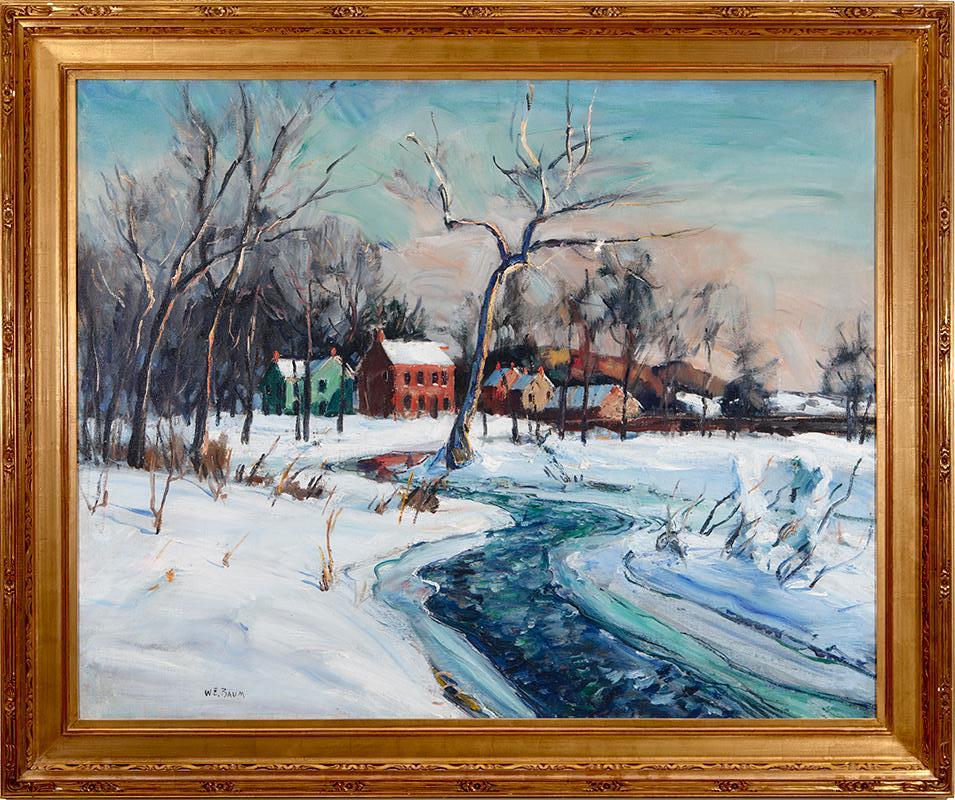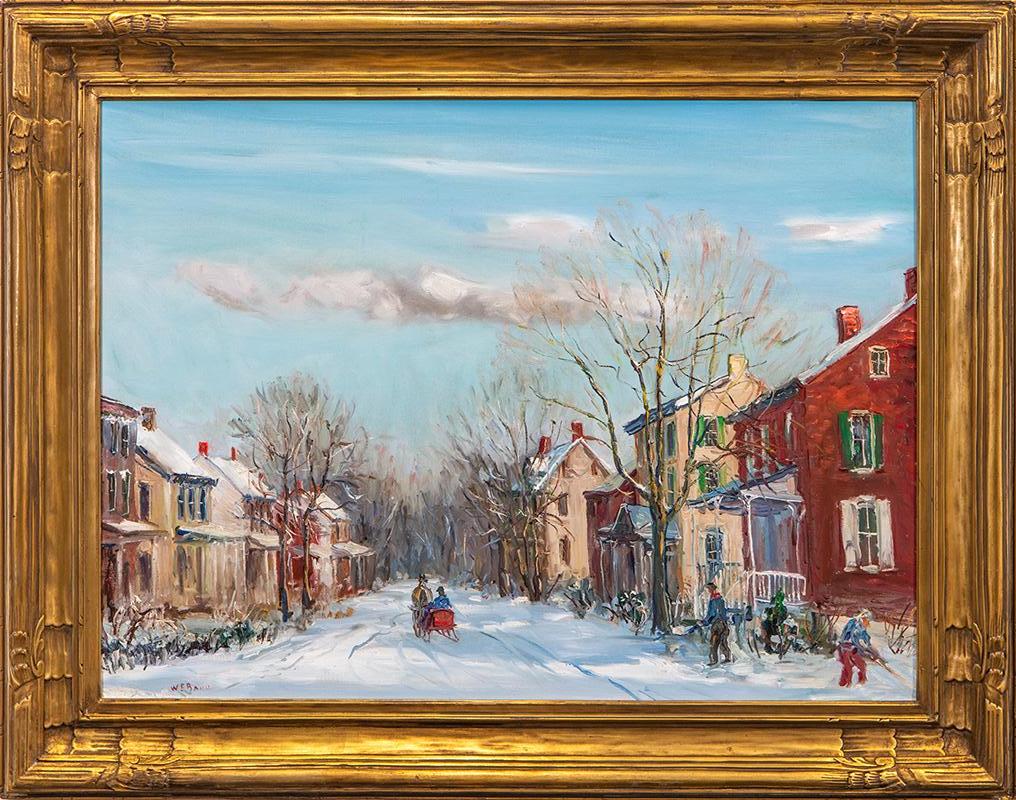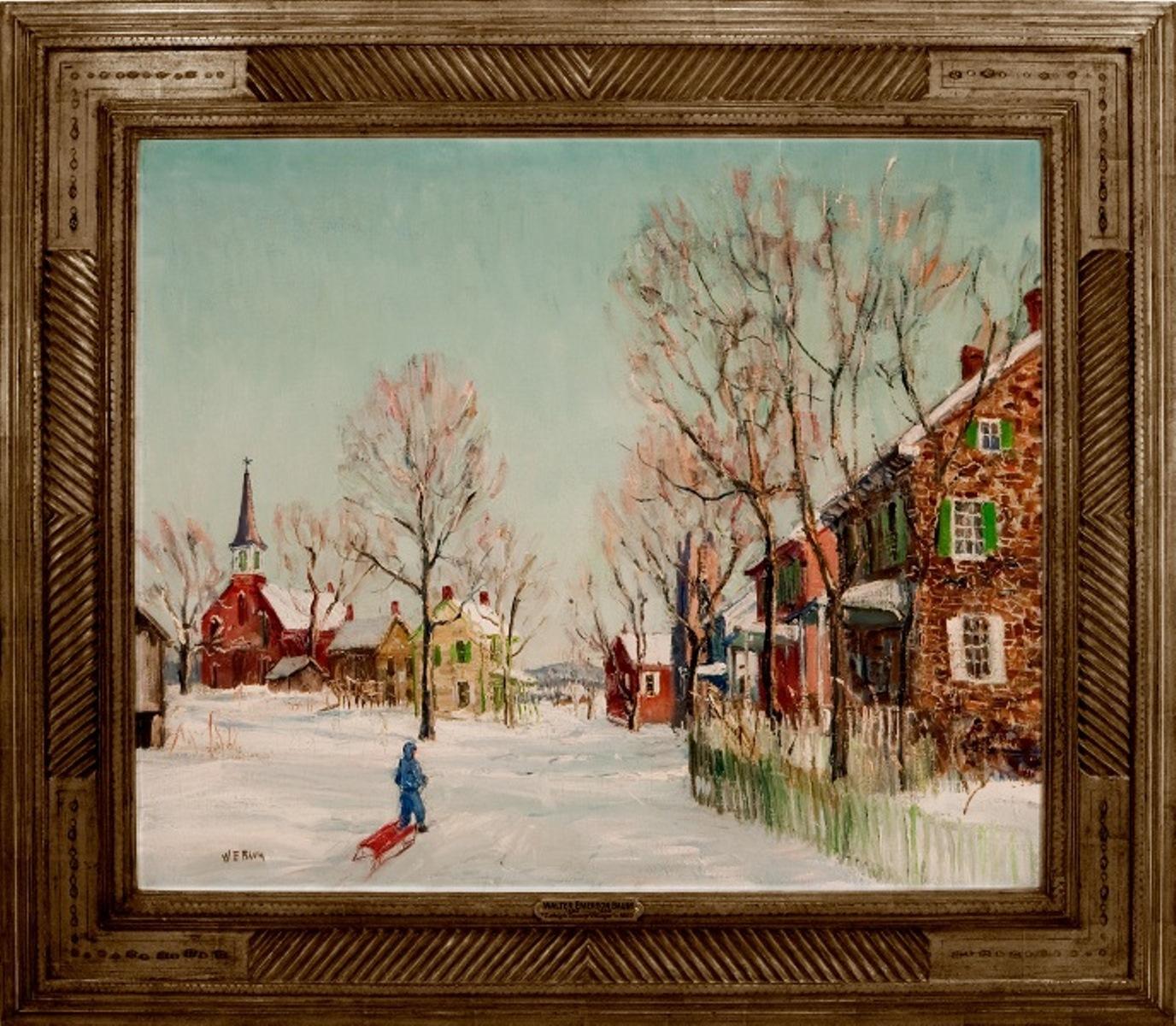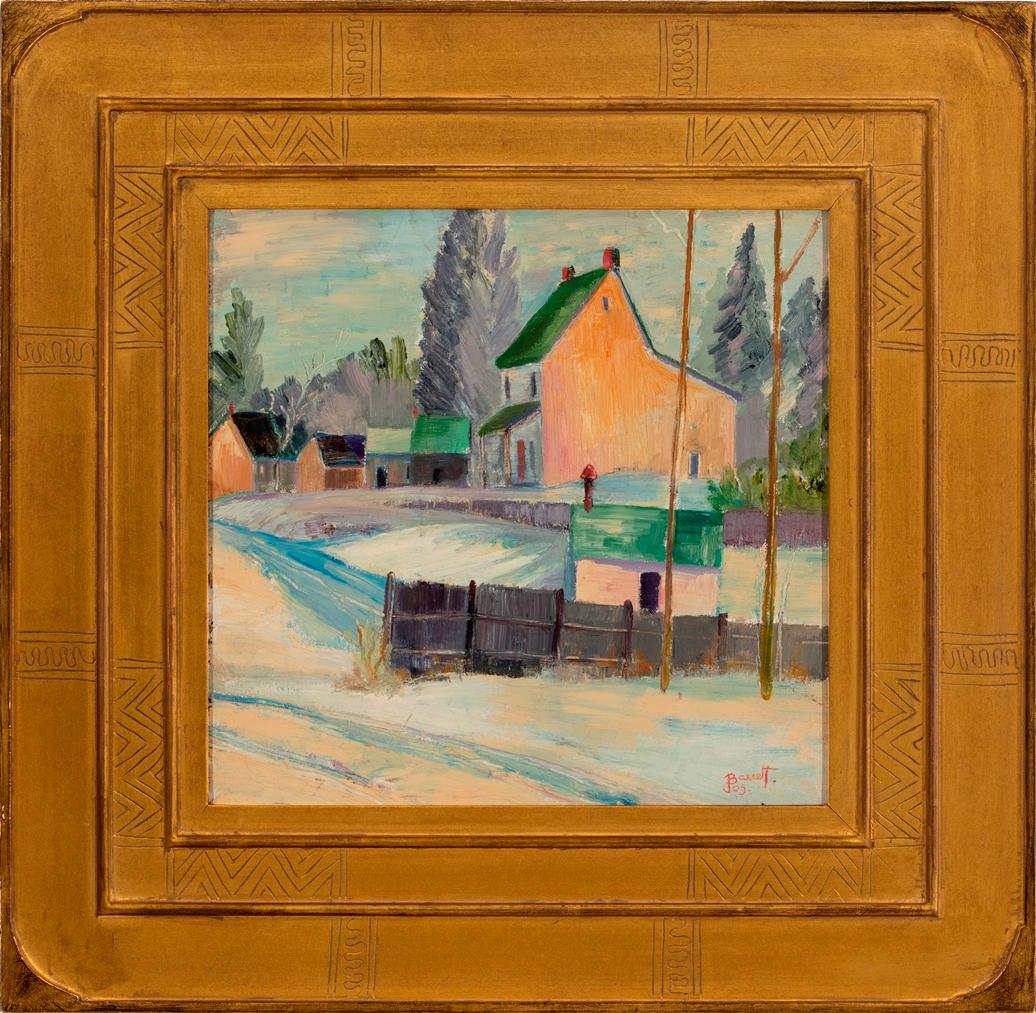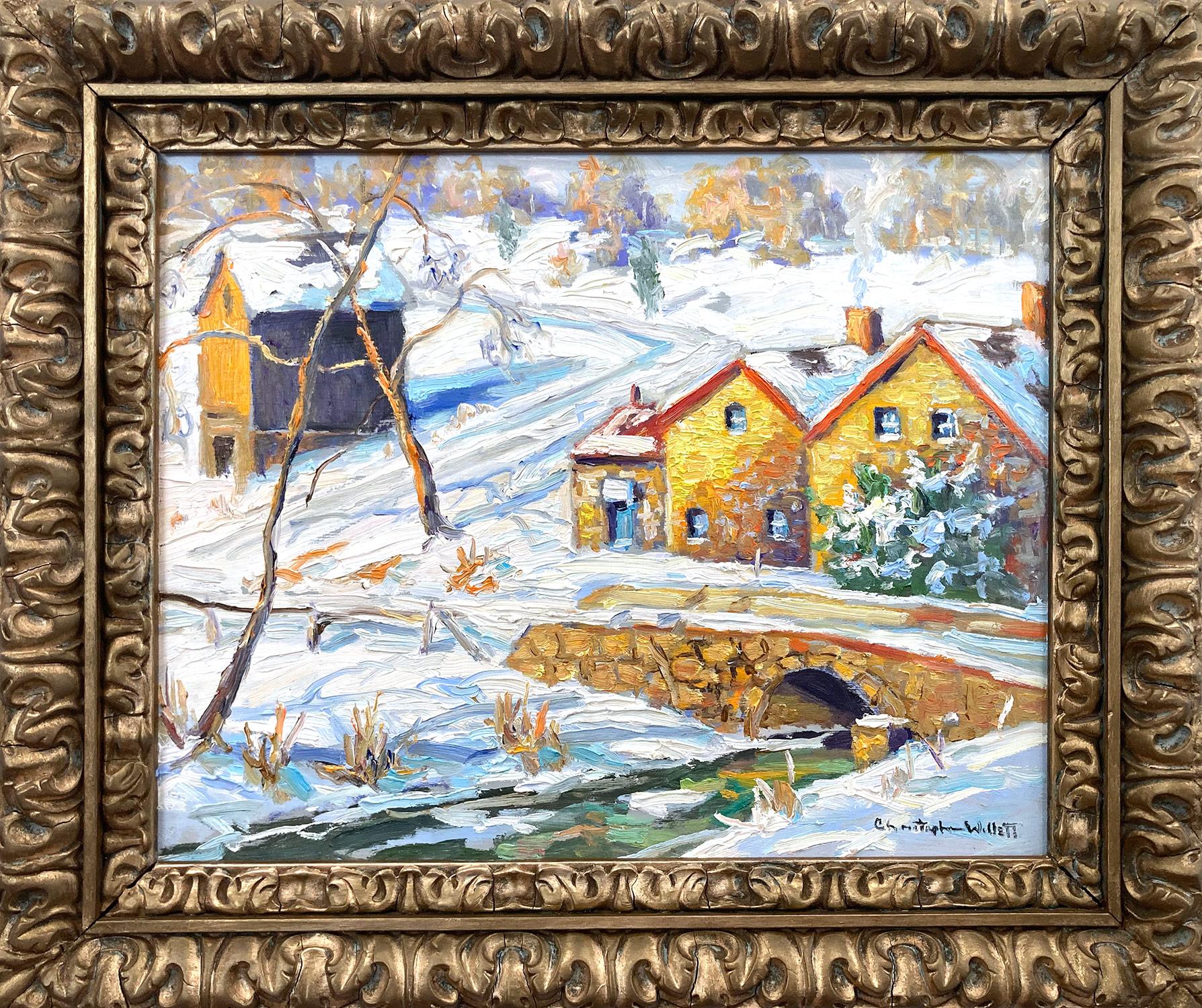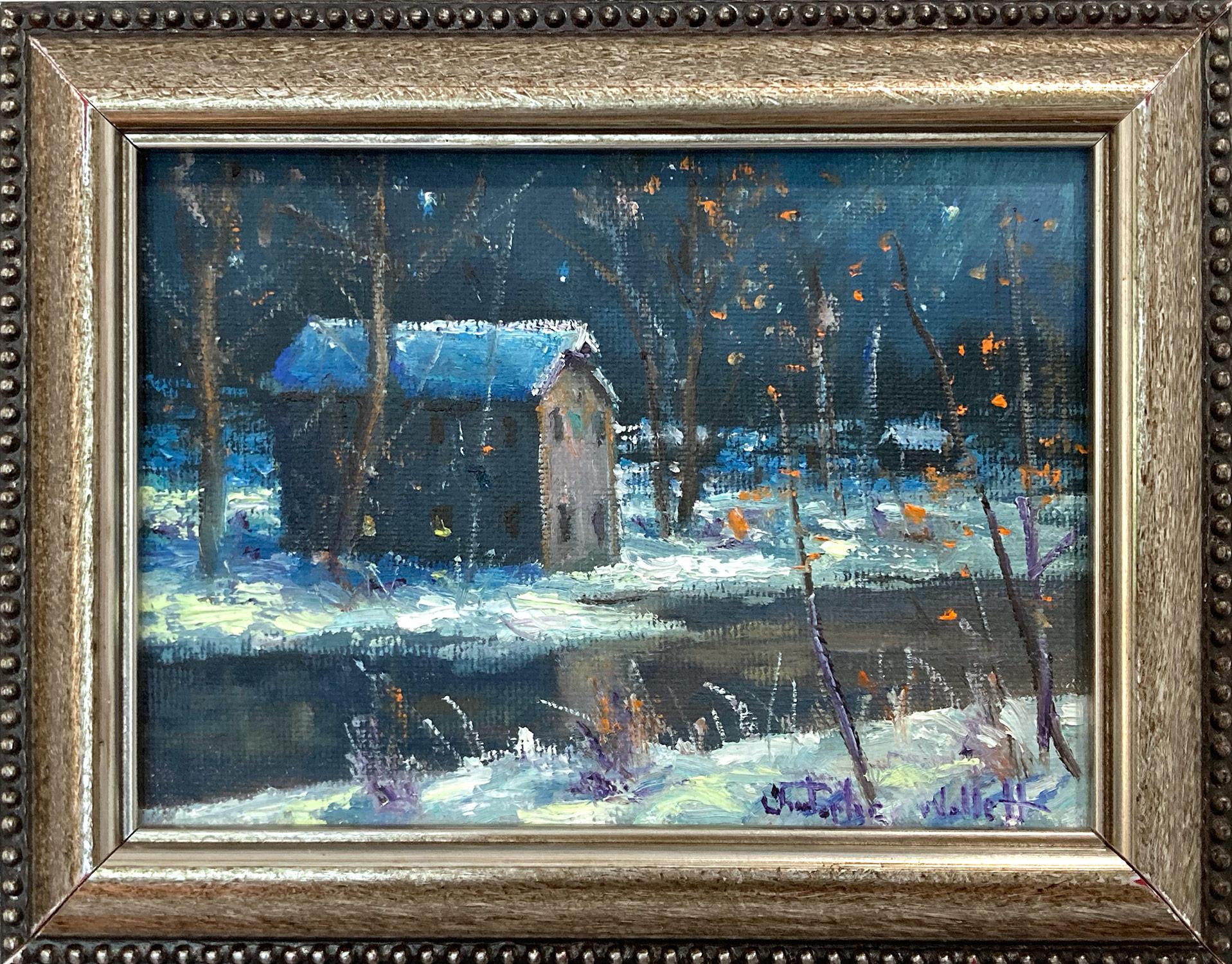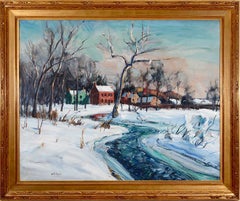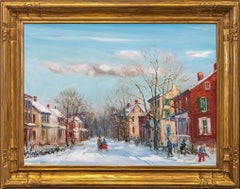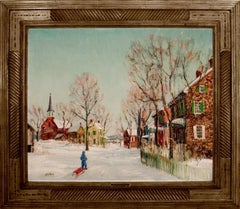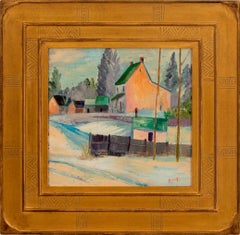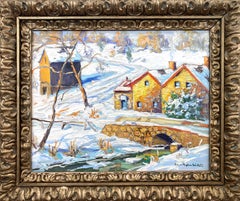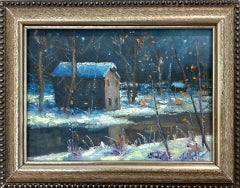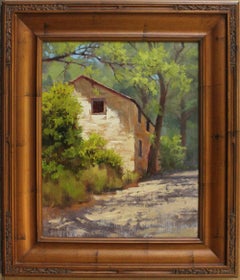Items Similar to "Bucks County Mill"
Want more images or videos?
Request additional images or videos from the seller
1 of 5
Walter Emerson Baum"Bucks County Mill"c. 1935
c. 1935
$86,875
£65,826.68
€75,399.14
CA$123,048.65
A$134,274.61
CHF 70,429.30
MX$1,630,809.92
NOK 879,700.59
SEK 831,361.06
DKK 562,750.69
About the Item
Jim's of Lambertville Fine Art Gallery is proud to present this piece by Walter Emerson Baum (1884 - 1956).
Born in Sellersville, Pennsylvania, Walter Baum was one of the only members of the New Hope Art Colony actually born in Bucks County. Greatly inspired by the painters of the original “New Hope School”, Baum had an extremely profound impact on artistic development throughout the Delaware Valley.
As an artist, there was no other to even come close in matching his highly prolific artistic production. His works were admired by both collectors and aspiring artists. His involvement in establishing an art school and museum in Allentown would have an enormous influence on what would become one of the largest artistic communities in the United States.
It was not until the age of twenty that Baum would begin his art studies first privately with William Trego, a respected local painter, followed by his enrollment to the Pennsylvania Academy of the Fine Arts, where his instructors included Thomas Anshutz and Daniel Garber. He was awarded the Jennie Sesnan Gold Medal from the Pennsylvania Academy in 1925.
Baum taught summer classes for the public schools of Allentown in 1926. The immense popularity of these classes would eventually lead to Baum co-founding the Kline-Baum School of Art in 1929 (later renamed the Baum School of Art). Baum also helped found the Allentown Art Museum in 1936, the Lehigh Art Alliance and the Circulating Picture Club. Baum wrote over five hundred reviews for the Philadelphia Bulletin as wells as Two Hundred Years, a study of the Pennsylvania Germans and their heritage. Baum did much to enrich the cultural environments of eastern Pennsylvania’s past. He received an honorary Doctorate of Humane Letters from Lehigh University in 1946.
During his long career, Baum worked in several mediums and painted in various styles. Many of his earlier works are magnificent impressionist landscapes of Bucks County and the Lehigh Valley showing the strong influence of Redfield and Schofield. Baum developed friendships with Schofield and Garber which deepened his appreciation for the regional landscape. In the late 1940s into 1950s, Baum’s style of painting changed completely, taking on modernist qualities similar to that of the French Post-Impressionist painters. These later works usually depict urban views of Allentown, Bethlehem and Easton as well as figurative works, still lifes and scenes portraying the students in his art classes and studio. Baum actively taught art and promoted artists throughout his life. As art editor of the Pennsylvania Bulletin, he wrote hundreds of reviews.
While he is known for his larger works, Baum painted over a thousand pictures of smaller sizes including extremely detailed 4 x 6-inch miniature landscapes. He would often paint the same scene again and again. Because of his unusually strong work ethic, not all of his many paintings are representative of his potential greatness. When studying his work, it is not uncommon to see several similar views of fair quality and then come upon a fine execution of the same scene. Great painters did not always paint great paintings, and when one was as prolific as Baum, this should be remembered and understood. There has always been a cloud cast upon Baum’s work by less knowledgeable collectors regarding forgeries and paintings finished and signed by the artist’s son. Granted, there are a lot of fake paintings bearing his name, but whether or not his son painted or signed them remains to be seen, but if a painting even looks remotely questionable, it is likely to be at best, of poor quality, and worst case a fake. Either or, this is not the kind of painting a collector should consider buying at any price. A Baum painting of investment quality will look like a fine painting and will not cast any doubt upon the trained eye.
- Creator:Walter Emerson Baum (1884-1956, American)
- Creation Year:c. 1935
- Dimensions:Height: 25 in (63.5 cm)Width: 30 in (76.2 cm)
- Medium:
- Movement & Style:
- Period:
- Condition:
- Gallery Location:Lambertville, NJ
- Reference Number:Seller: JOL1119220311stDibs: LU37412379622
Walter Emerson Baum
Born of Pennsylvania Dutch extraction on December 14, 1884, Walter Baum painted among the villages and cities of these people. A pupil of W. T. Trego and the Pennsylvania Academy of the Fine Arts, he was a member of many organizations, including the Philadelphia Art Alliance, the Philadelphia Sketch Club, the Germantown Art League, the Fellowship of the Pennsylvania Academy of the Fine Arts, the Philadelphia Watercolor Club, Associate of the National Academy of Design in New York, the Salmagundi Club, the Woodmere Art League, and many others. Baum was the art editor of the Philadelphia Evening Bulletin, editor of the Sellersville Herald, a contributing artist of the Curtis Publishing Company, an illustrator for Story Classics, director of the Allentown Museum and head of Kline-Baum Art School in Allentown, PA. He was also a member of the New Hope Art Associates. The artist was a recipient of many awards, including the bronze medal from the American Artists' Exhibition in Philadelphia; the Jennie Sesnan Gold Medal from the Pennsylvania Academy; the Zabriskie Prize from the American Watercolor Society; and the Purchase Prize from the Buck Hill Art Association. He exhibited at the Pennsylvania Academy Annual Oil and Watercolor Exhibition; the Corcoran Art Gallery Biennial, Washington, D.C.; the National Academy of Design, New York; the Chicago Art Institute; and at many others throughout the country. Baum's paintings are represented in many private and permanent collections, including the Philadelphia Museum of Art, Toledo Art Museum, National Academy of Design, and the collection of the late President Franklin Delano Roosevelt. Walter Emerson Baum died in 1956.
About the Seller
5.0
Vetted Professional Seller
Every seller passes strict standards for authenticity and reliability
Established in 1997
1stDibs seller since 2014
39 sales on 1stDibs
Typical response time: 1 to 2 days
- ShippingRetrieving quote...Shipping from: Lambertville, NJ
- Return Policy
Authenticity Guarantee
In the unlikely event there’s an issue with an item’s authenticity, contact us within 1 year for a full refund. DetailsMoney-Back Guarantee
If your item is not as described, is damaged in transit, or does not arrive, contact us within 7 days for a full refund. Details24-Hour Cancellation
You have a 24-hour grace period in which to reconsider your purchase, with no questions asked.Vetted Professional Sellers
Our world-class sellers must adhere to strict standards for service and quality, maintaining the integrity of our listings.Price-Match Guarantee
If you find that a seller listed the same item for a lower price elsewhere, we’ll match it.Trusted Global Delivery
Our best-in-class carrier network provides specialized shipping options worldwide, including custom delivery.More From This Seller
View All"Perkiomen Mills"
By Walter Emerson Baum
Located in Lambertville, NJ
Jim’s of Lambertville Fine Art Gallery is proud to present this piece by Walter Emerson Baum (1884 - 1956).
Born in Sellersville, Pennsylvania, Walter Baum was one of the only membe...
Category
1930s American Impressionist Landscape Paintings
Materials
Canvas, Oil
"Christmas Time, Sellersville"
By Walter Emerson Baum
Located in Lambertville, NJ
Jim’s of Lambertville Fine Art Gallery is proud to present this piece by Walter Emerson Baum (1884 - 1956).
Born in Sellersville, Pennsylvania, Walter Baum was one of the only membe...
Category
1930s American Impressionist Landscape Paintings
Materials
Canvas, Oil
"Lehigh County Village"
By Walter Emerson Baum
Located in Lambertville, NJ
Jim’s of Lambertville is proud to offer this artwork by:
Walter Emerson Baum (1884 - 1956)
Born in Sellersville, Pennsylvania, Walter Baum was one of the only members of the New Ho...
Category
1930s American Impressionist Landscape Paintings
Materials
Canvas, Oil
"Bucks County Village"
By Joseph Barrett
Located in Lambertville, NJ
Illustrated in "Joseph Barrett, The Prime Years 1970s - 1990s", pg. 64, plate #074.
Category
Late 20th Century American Impressionist Landscape Paintings
Materials
Oil, Board
"Pennsylvania Dutch Village"
By Walter Emerson Baum
Located in Lambertville, NJ
Jim’s of Lambertville is proud to offer this artwork by:
Walter Emerson Baum (1884 - 1956)
Born in Sellersville, Pennsylvania, Walter Baum was one of the only members of the New Ho...
Category
1930s American Impressionist Landscape Paintings
Materials
Canvas, Oil
"Little House, Lambertville, NJ"
By Joseph Barrett
Located in Lambertville, NJ
Jim’s of Lambertville is proud to offer this artwork.
Signed lower right
Joseph Barrett (b. 1936)
Joseph Barrett was born in Midland, North Carolina, in 1936 and studied at the M...
Category
20th Century American Impressionist Landscape Paintings
Materials
Oil, Canvas
You May Also Like
"Early Morning Carversville PA Bucks County" Pastoral Snow Scene Oil Painting
Located in New York, NY
A wonderful Impressionist Snow covered pastoral scene of the colorful and quaint early morning Carversville Pa Bucks County. Willet has portrayed this piece in a most intimate, yet energetic way, and has packed much feeling into this large scale work. It is almost as if we are there in the snow in the early morning, bringing a beautiful feeling of nostalgia. Christopher is known for capturing the beauty and simplicity of an earlier time of the 20th Century; old New York, families working together, villages and farms and friends taking walks together. Many are depicted in recognizable historical settings and this piece is an excellent example of this as he captures a snow-filled historic setting of Bucks County with the calm, endearing charm of a snowy morning. Christopher engages his audience with the quick use of brushwork and great attention to picking up the energy passionately of his subjects. This piece is signed lower right and it comes housed in a wood carved antique gold tone wood frame ready to be displayed with hanging with wire on verso.
Art measures 12.5 x 15.5 inches
Frame measures 15 x 19 inches
Christopher Willett, was born in 1959 in Bucks County Pennsylvania and is mostly known for his landscape paintings. Willett, a painter with a family lineage dating back to ancestors arriving in this country aboard the Mayflower and Victory, settling Plymouth. Some recorded family history finds a Willett ancestor, Augustine Willett whom was a Captain of historic repute under the command of General Washington. Additionally, in more recent history, Willett artisans became renowned for their designs and beautiful works in stained glass that adorn the Bryn Athen Cathedral- for the Pit Cairn estate.
Willett, is also a descendant of the renowned painter Edward Hicks...
Category
20th Century American Impressionist Landscape Paintings
Materials
Oil, Board
"Mill Along Neshaminy Creek" Bucks County Snow Scene Landscape Oil Painting
Located in New York, NY
Impressionist winter pastoral scene of a quaint snow covered home by the Mill Along Neshaminy Creek in Bucks County, PA. Willett has portrayed this charming mill scene in a most inti...
Category
20th Century American Impressionist Landscape Paintings
Materials
Oil, Board
Bucks County Winter Landscape
By Paul Bernard King
Located in Milford, NH
A wonderful winter village landscape in Bucks County by painted by American artist Paul Bernard King (1867-1947). King was born in Buffalo, New York, and ...
Category
Early 20th Century American Impressionist Landscape Paintings
Materials
Canvas, Oil
"LANGE'S MILL" FROM THE CREEK
Located in San Antonio, TX
Chuck Mauldin
Born 1949
Fredericksburg Artist
Size: 20 x 16
Frame: 24 x 20
"Lange's Mill from the Creek"
A native of Texas, Chuck Mauldin has been painting in oil since the age of twelve. His interest in watercolor and pencil drawing grew during his years spent in Louisiana. With his move back to Texas, he has renewed his focus on oil painting, using this medium in a realistic yet painterly style. Striving to quickly capture color and mood with a direct "alla prima" technique is one of his main objectives in painting outdoors on-location. Cows, cowboys and Native Americans often enrich the landscape in his studio work, while anything can inspire his plein air paintings.
Workshops with Charles Sovek...
Category
20th Century American Impressionist Landscape Paintings
Materials
Oil
"Along The Creek" Point Pleasant Pike Bucks County Bucks County PA River Snow
Located in New York, NY
A wonderful Impressionist winter pastoral scene of colorful quaint homes by the river. Willet has portrayed this piece in a most intimate, yet energetic way, and has packed much feel...
Category
20th Century American Impressionist Landscape Paintings
Materials
Oil, Board
"Along the Tinicum Creek" Bucks County PA Snow Scene Landscape Oil Painting
Located in New York, NY
Impressionist winter pastoral scene of a quaint snow covered home in Tinicum, Bucks County, PA. Willett has portrayed this charming scene in a most intimate, yet energetic way, and h...
Category
20th Century American Impressionist Landscape Paintings
Materials
Oil, Board
More Ways To Browse
Brown County Art
Thomas Anshutz
Bucks County Impressionists
Bucks County Painting
Bucks County Oil
Bucks County Art
Thomas Daniel
Emerson Oil Painting
Robinson Oil Painting
Welsh Artist
British Victorian Landscape Paintings
Landscape Painting With Green
Used Canvas Sails
Venetian Canal
Wales Landscapes
Windmill Paintings
Hugues Claude Pissarro
Industrial Landscape Art
